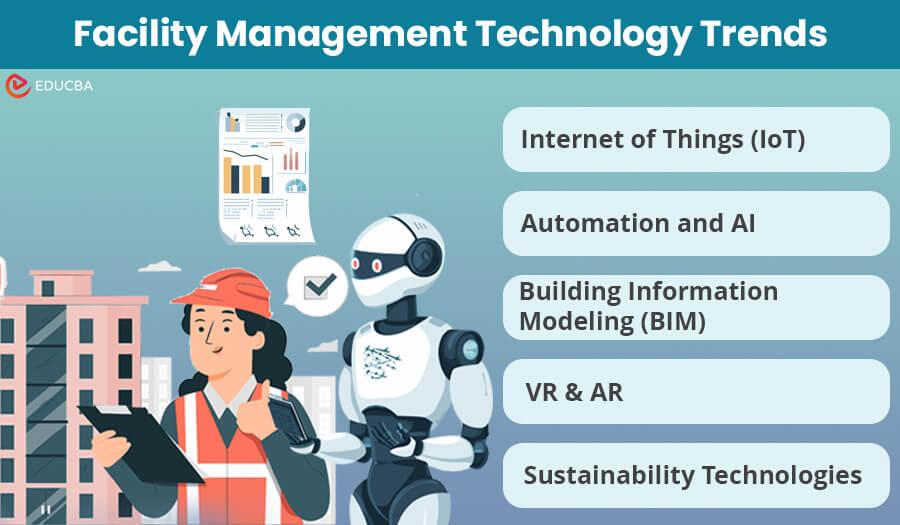
Why Do You Need Facility Management Technology?
Facility management means maintaining the buildings in which firms operate. Imagine managing a facility where all processes are outdated. It leads to inefficiencies, increased costs, and missed opportunities. Clinging to conventional methods in an industry where a minor mistake can cause significant downtime and financial losses is not efficient. That is why companies need to adapt to facility management technology trends to stay competitive.
The latest technological trends, including cloud-based facility maintenance management software, IoT, and AI-driven predictive maintenance, are reshaping facility management. By embracing these technologies, facility management can unlock efficiency, sustainability, and competitiveness.
In this article, we present facility management technological trends and strategies for integrating them into your existing operations.
Facility Management Technology Trends 2024
1. Internet of Things (IoT)
IoT is dramatically transforming FM by enabling real-time monitoring and management of facilities. Sensors and connected devices provide insights into various aspects of facility operations, such as energy usage. It can help firms reduce significant costs and improve operational efficiencies.
Moreover, smart HVAC (Heating, ventilation, and air conditioning system) control systems improve efficiency and comfort.
2. Automation and AI
The use of AI and machine learning in FM facilitates predictive maintenance. This approach anticipates potential equipment issues, which helps to repair problems on time and reduce downtime and repair costs.
Furthermore, automation can control various systems simultaneously without the need for manual intervention. Moreover, automated systems can also generate alerts for maintenance needs or security breaches. Overall, AI and automation help facility managers save time, reduce costs, and ensure smoother operations.
3. Building Information Modeling (BIM)
BIM is when you create a 3D model of the facility you are managing, from the building’s spatial geometry to its material. In facility management, BIM helps streamline tasks such as space management, maintenance planning, energy analysis, and asset tracking.
Moreover, another such software, EAM (Enterprise Asset Management), helps companies handle maintenance, operations, and the lifecycle of physical assets like equipment and facilities. It streamlines processes by tracking assets, scheduling maintenance, managing work orders, controlling inventory, and analyzing performance.
4. Virtual Reality (VR) & Augmented Reality (AR)
Virtual reality provides immersive virtual tours that owners can use to remotely explore properties and showcase them to clients during leasing. It also offers realistic training simulations for facility management staff, improving emergency response and maintenance skills.
On the other hand, augmented reality facilitates remote inspections and real-time data sharing during on-site assessments. It also allows technicians to access step-by-step repair instructions and diagrams.
5. Sustainability Technologies
The growing emphasis on global sustainability is influencing facility management technology. Innovations in energy and water monitoring and management are becoming more important in FM. Implementing these technologies not only reduces facilities’ environmental impact but also aligns with sustainability goals.
6. Visitor Management System
Visitor management means overseeing and controlling who enters the facility, from employees to technicians. It includes registering visitors, issuing visitor passes, monitoring their activities, and ensuring on-site safety.
Visitor management systems automate these tasks, which makes visitor check-in and check-out processes efficient and accurate. Effective visitor management helps facilities maintain a safe and welcoming environment while ensuring regulatory compliance and protecting sensitive information.
Strategies for Adapting to Technological Changes in Facility Management
Facility managers need to be proactive in adapting to these technological shifts. It requires continuous learning, strategic planning, and an openness to embracing new technologies.
Yogesh Choudhary, CEO of FieldCircle, emphasizes this perspective: “In the dynamic field of facility management, staying ahead means embracing change as an opportunity. By integrating cutting-edge technologies, we enhance operational efficiency and pave the way for innovative and sustainable facility solutions.”
Here are some strategies you can use to adopt the new technologies in your workplace.
- Invest in Training: Ensuring that the FM team is well-versed in new technologies is crucial. Thus, continuous training and development are necessary for staff to utilize and benefit from these tools effectively.
- Develop a Technology Plan: A strategic plan for technology integration involves assessing current processes and identifying areas where technology can bring improvements. It is essential for successful technology implementation in FM operations.
- Embrace Data-Driven Decision-Making: Leveraging data analytics in FM leads to more informed decision-making. Facility managers can utilize data insights to optimize operations and improve facility performance.
- Prioritize Cybersecurity: As FM becomes increasingly digital, cybersecurity becomes a paramount concern. Implementing robust cybersecurity measures is crucial to protect sensitive data and maintain the integrity of facility management operations.
Final Thoughts
Adapting to technological changes in facility management is ongoing and requires a strategic, open-minded approach. The key to successful adoption is continuous learning, strategic planning, and embracing the potential of new technologies. Facility managers who embrace these changes can contribute to a more sustainable future.
Recommended Articles
We hope you employ these strategies to implement the changing facility management technology at your workplace. For similar strategy-based content, visit the following articles.

